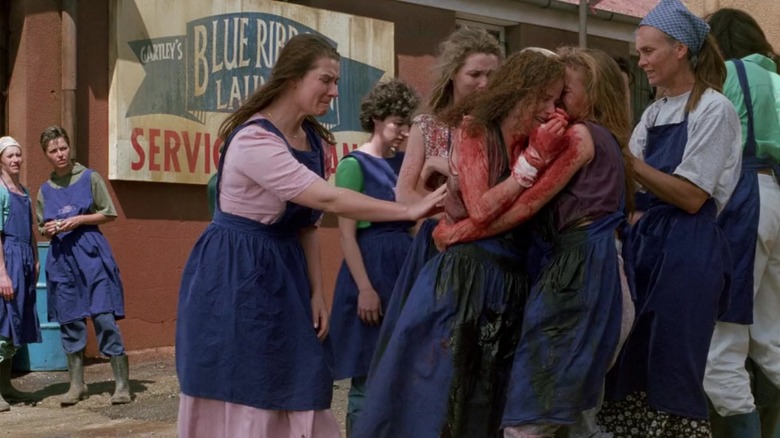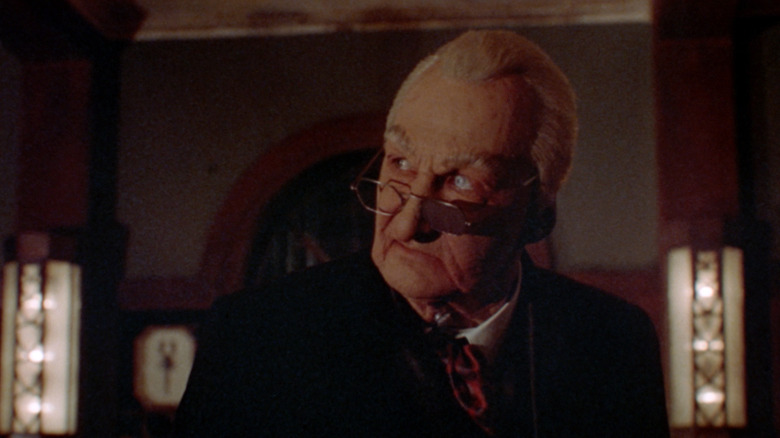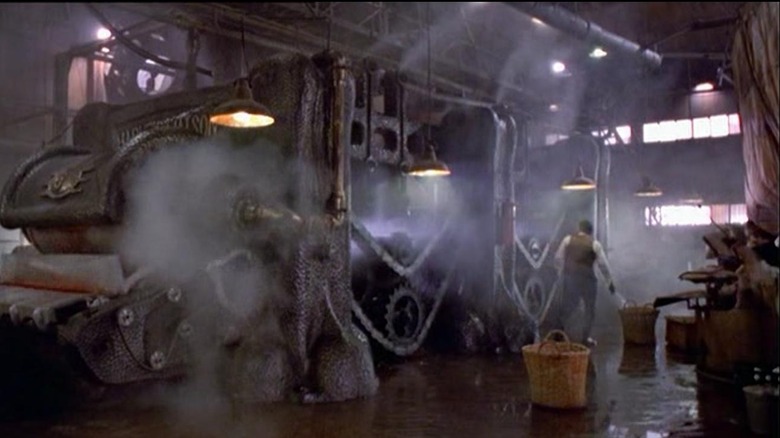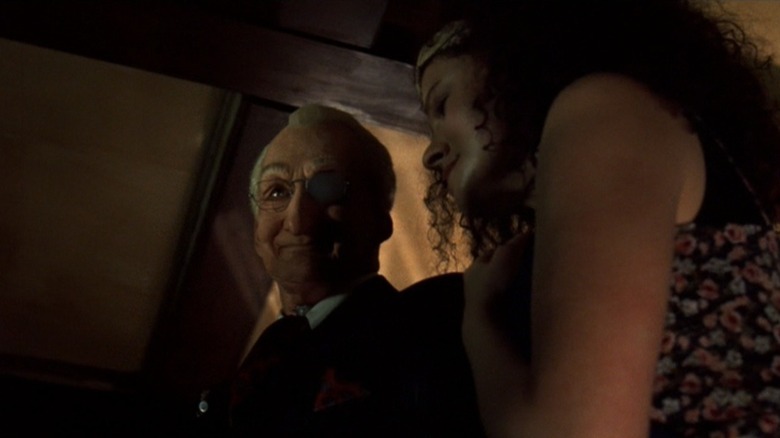Why Stephen King And Tobe Hooper's The Mangler Was A Box Office Disaster
In the modern context, it's easy to think of Stephen King as a man who has conquered all mediums in the entertainment industry with ease. Not only is he one of the most prolific and accomplished authors of all time, but his books have inspired dozens of adaptations both on the big and small screen. 2017's "It" went on to shatter records at the box office and prompted a new wave of movies based on King's work that will be coming out over the next handful of years. But on the movie side of things, it wasn't always that way — "The Mangler" is a perfect example of the other side of that equation.
The film was based on one of King's short stories from his cherished "Night Shift" collection, and to make matters all the more promising, Tobe Hooper ("The Texas Chain Saw Massacre") was hired to direct the film. And he wasn't the only horror legend along for the ride, as Freddy Kreuger himself, Robert Englund, signed on for one of the leading roles alongside "Silence of the Lambs" star Ted Levine. On paper, this had absolutely everything going for it, especially considering that this was 1995 and the horror genre was in need of a pick-me-up (though that wouldn't ultimately come until "Scream" hit theaters in 1997).
So, what were we working with when it comes to "The Mangler?" The movie's official synopsis reads as follows:
Workers at the Blue Ribbon Laundry have been having a suspicious number of deaths while working on a piece of machinery known as "The Mangler." When Police Officer John Hunton (Ted Levine) decides it's time to investigate why, he learns that the laundry's owner, Bill Gartley (Robert Englund) has purposely been sacrificing young virgins to the possessed machinery in order to maintain his and the town's other elders prosperity.
No doubt about it, that is a wild premise and perhaps not one audiences in the '90s might be expecting when they headed to the movies. The title suggests a straight-forward slasher movie, but the end result was anything but. Unfortunately, that proved to be devastating for New Line Cinema, who ponied up the dough to make this adaptation happen.
A devastatingly bad opening weekend
"The Mangler" hit theaters on March 3, 1995 and was pretty much dead on arrival. It opened with a lousy $1.1 million on 800 screens, which was a nail in the coffin come Monday morning for New Line. There was no saving this from disasterville, with the movie finishing its run in theaters with just $1.8 million total. Granted, this was at a different time, and home video sales could help save a movie, especially horror films as they could do quite well at big box rental chains such as Blockbuster. Not to mention that horror movies are often produced on the cheap, meaning they need to make far less to be considered hits. That is important to remember as we unravel this disaster.
It wasn't very good (and it was a bit misleading)
So, what went wrong here? Well, first and foremost, critics were not kind to the movie, and "The Mangler" currently holds a mere 27% approval rating on Rotten Tomatoes. That certainly didn't help matters. It is also important to remember that the horror genre was struggling at this point in time after experiencing a huge boom in the '80s thanks to franchises like "A Nightmare on Elm Street" and "Friday the 13th." Audiences just weren't turning up in droves even for sure bets at the time, let alone something with no critical buzz about a (checks notes) killer laundry machine.
Hooper delivered one of the greatest horror films of all time, Englund was one of the most iconic slashers ever on screen, and Levine was coming off of a chilling performance just a few years earlier as Buffalo Bill. Audience expectations didn't line up with what was delivered here. This was not a straightforward slasher — it was kind of meant to be campy. And perhaps part of the problem is that King's story very much leans into this, short though it may be, while the movie doesn't ever fully commit. The marketing and the pieces that were in play ultimately made "The Mangler" misleading, failing to generate any buzz. With the benefit of hindsight, it's easy to see why this didn't pan out upon its initial release.
Not all was lost
One of the nice things about horror movies is that, unlike almost any other genre of film, even a seemingly disastrous flop can become a modest hit and spawn a franchise. To that end, "The Mangler" apparently did well enough on home video relative to its budget to actually make some money. Or, at the very least, enough to make someone believe that some direct-to-video sequels made on the cheap would bring in enough cash to justify their existence. So, amazingly enough, despite a horrendous turnout at the box office originally, not one but two sequels were produced.
The first sequel arrived in 2002 in the form of "The Mangler 2," directed by Michael Hamilton-Wright. It wasn't embraced critically and was accused of being similar to "The Lawnmower Man" while having virtually nothing to do with the first movie. Yet, it paved the way for another unlikely sequel in the form of 2005's "The Mangler Reborn," which was actually distributed directly to DVD by Lionsgate, the studio behind the "Saw" franchise. This one, directed by Erk Gardner and Matt Cunningham, similarly not doing too well with critics but serving as an alternate sequel to the original.



